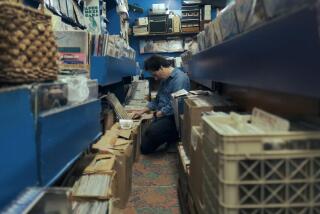Review: ‘Don’t Blink — Robert Frank’ profiles one of America’s most iconic, idiosyncratic photographers
Films focused on visual artists are a staple of the documentary world, but “Don’t Blink — Robert Frank” does things a little differently. Rather than being a film about an artist, it’s an attempt to show us what it’s like to actually be an artist.
Swiss-born Frank has, at age 91, been called the most influential photographer alive. If Americans designated people as living cultural treasures the way the Japanese do, he would be at the top of the list.
Frank is best known for the enormously influential “The Americans,” a 1958 book that resulted from a nine-month trip the artist, financed by a Guggenheim grant, took to 30 states that resulted in 27,000 photographs, which he culled to a stunning 83 images.
But though they’re less well known, Frank also directed a number of independent/experimental films, starting with his Jack Kerouac-narrated “Pull My Daisy” (1959) and including a controversial 1979 Rolling Stones documentary with an unprintable title that a lawsuit by the group has made difficult to see even now.
“Don’t Blink” is directed by Laura Israel, Frank’s film editor for more than 20 years, and includes generous selections from those works. Having a filmmaker that Frank is comfortable with in charge means that the photographer lets his guard down here more than he might have with a relative stranger.
I hate to be photographed. I can’t stand to be pinned in front of a camera. I do that to people, I don’t like it done to me.
— Robert Frank
More free-form than straight ahead, “Don’t Blink,” photographed by Lisa Rinzler, is an idiosyncratic look at an idiosyncratic man. It mixes nuggets of traditional biographical information with time spent just hanging out with Frank, situations where the artist’s restlessness, his unwillingness to settle for the expected, are in full view.
In addition to getting a glimpse of Frank’s cluttered New York residence, we see him at his second home in remote Mabou on Nova Scotia’s Cape Breton Island. “It’s cold, you have to slow down, it’s the opposite of New York,” he says. “I wouldn’t say it’s hard, it’s impossible.”
“Don’t Blink” also has access to earlier footage of Frank, and it makes especially good use of a 1985 interview that shows the artist at his most irascible and acerbic.
“I do it my way, I don’t want to make compromises,” the man says, revealing as well “I hate to be photographed. I can’t stand to be pinned in front of a camera. I do that to people, I don’t like it done to me.”
The documentary also emphasizes Frank’s affinity for boundary-pushing individuals, not only Kerouac, Allen Ginsberg and the entire Beat Generation crew but also Stewart Brand, editor of the Whole Earth Catalog, and the eccentric musicologist Harry Smith. “I prefer to work on the edge, not the middle of the road,” Frank says. “I am looking for chaos.”
“Don’t Blink” also offers glimpses of the photographer’s personal life, including the tragic early deaths of both of his children. And time is spent with his wife, fellow artist June Leaf, who says her first impressions of Frank was as both “arrogant and sweet.”
Though what he says is always direct and to the point, as when he says of himself, “I am a hunter, I hunt for pictures,” Frank insists “I’m not a verbal man. I have nothing to reveal. It’s all in the work, I hope.” Honoring that sentiment is what this very personal film is all about.
More to Read
Only good movies
Get the Indie Focus newsletter, Mark Olsen's weekly guide to the world of cinema.
You may occasionally receive promotional content from the Los Angeles Times.











